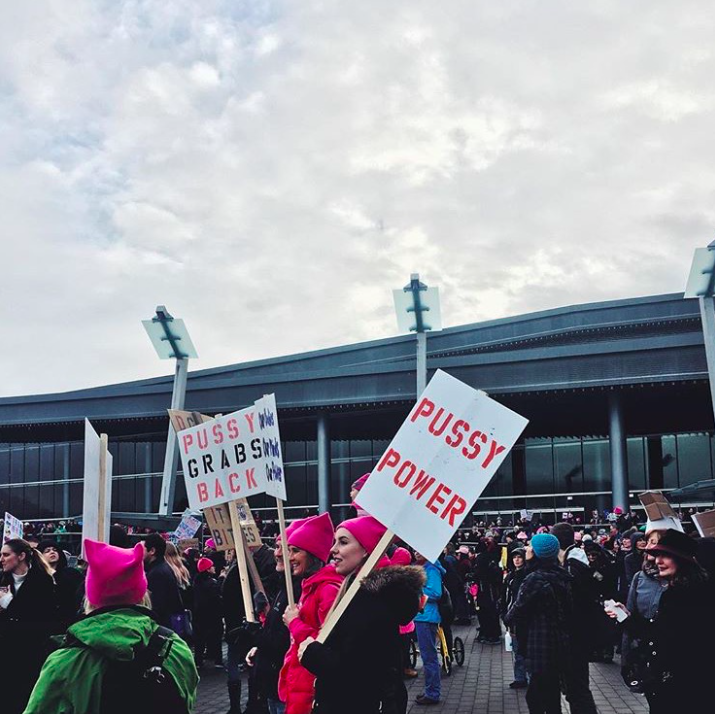Feminist Futures
From the photo, most people would recognize the distinct pink-eared hats instantly. This photo was taken in front of Jack Poole Plaza on January 21st, 2017, where over 15,000 men and women of all ages, ethnicities, sexes, races – they all gathered to support the Women’s Movement, the day after Trump’s inauguration. Not only did women and men in Canada partake in the march, but people from all over North America and beyond, showing their support and solidarity with women.
This photo to me symbolizes more than just a bunch of activists standing together – it shows me a brighter future; a more equal future. To me when I look back on this photo, or reminisce to that day, it makes me think of how far women have come, including myself. Not that I would ever consider myself an uneducated person in regards to feminism and women’s rights, but my mind was not fully enlightened to the ideas of feminism outside a Western context until I started here at UBC. And that’s the reason I chose to wait to write on the last topic, “global feminist futures”, because I wanted a platform to showcase not only the knowledge gained from this class but the gratitude I feel towards having been exposed to these certain topics and concerns about feminist futures not singularity in a Western perspective, but globally, across all borders.
These ideas on the future of feminism was shown in Katie McDonald’s article “Calls for Educating Girls in the Third World: Futurity, Girls, and the ‘Third World Women’” she talks about how women, especially third world women, are seen in a very specific way. The article begins with discussing the very narrow and unrealistic view that many Westerners imagine when they think of the “third world”. “Death and suffering are said to haunt these representations, with children portrayed as emaciated, and perpetually in need of Westerners’ support for survival” (MacDonald 2016: 1). Especially with women and young girls – many people have stereotyped assumptions when it comes to imaging a young female in such living conditions. For me, I was definitely one of those people who had very superficial ideals about third world countries, but through taking courses this year in GRSJ – my perspective is a lot broader and clearer. I can see situations from different perspectives and how different cultures can reflect different things.
One specific example from MacDonald’s article is the “Because I Am a Girl” campaign, and their benefits to females in third world countries. It furthers the look into this campaign, that which has viral videos on their social media accounts, discussing these ideas for change. Before taking this class, myself I would have seen their campaigns as“inspiring”. I would have been sucked into the cartons and the light-hearted messages; probably shared it on social media, and felt like I did something “good” for the campaign. But now, when I see ads and magazine spreads – my mind connects the dots quickly on the apparent racism, sexism and blatant outsourcing of cultures that only help to perpetuate these unrealistic ideals and expectations of other races/gender/countries. In the add – my mind automatically raced with the idea that this campaign – and the message behind it- is that it is entirely up to the girl to shape her own future all while taking care of her family – just like the norms perpetuated by society. As MacDonald’s article explains:
“Each of these perspectives on how gender is included in development takes different perspectives – from women being imagined as agents different from men, to women being agents of development and finally to considering the ways in which gender (rather than women) was the crux point. Although scholars are critical of the positioning of women’s bodies as a site for widespread change, women’s bodies have remained sites for development in practice and this has meant that women’s bodies become sites of contestation for measuring a country’s development. These characteristics are often very visual and tangible, such as female circumcision, veils or seats in a classroom. Women come to represent the status of communities and countries” (MacDonald 2016: 7)
So, when thinking of the future of feminism I think of myself, and millions of other girls and guys out there who can benefit from a more in-depth education on the topic, and through this knowledge will help shape the future. We are the future generation that will be shaping our future, and their ideals will carry and change with them as they grow. They hold the key to feminist futures – and not just the stereotypical Western feminist future. These ideas talked about during the class – and this article – helped shape my view on differences in society and differences around the world. How something as simple as a campaign ad, though it may only be 1 in the millions of ads we will see in our life, perpetuates such blatant sexism towards young women. This class – and events that shape our lives like the Women’s March – are steps to a brighter future.
MacDonald, Katie. (2016). Calls for educating girls in the Third World: futurity, girls and the ‘Third World Woman’. Gender, Place and Culture, 23(1):1-17.
